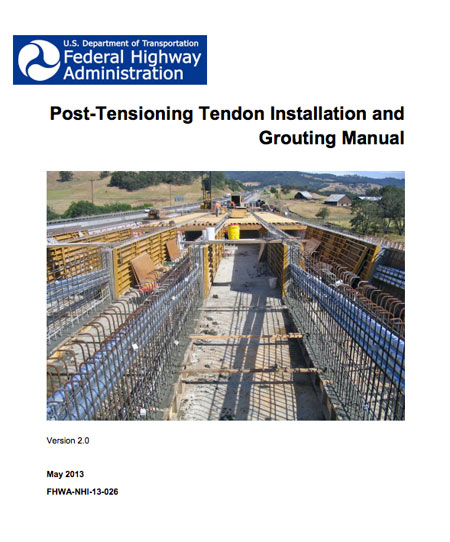U.S. Department of Transportation
Federal Highway Administration
1200 New Jersey Avenue, SE
Washington, DC 20590
202-366-4000
Focus
| Accelerating Infrastructure Innovations |
Publication Number: FHWA-HRT-14-009
Date: December 2013
Printable Version (.pdf, 0.3 mb)
Over the last half of the 20th century, the introduction of prestressed concrete bridges represented a major advancement for bridge construction, offering a range of new engineering solutions and aesthetic possibilities.
The construction of these bridges requires, however, that the concrete be prestressed by using either pretensioning or post-tensioning strategies to reduce cracking and increase durability. The Federal Highway Administration's (FHWA) updated Post-Tensioning Tendon Installation and Grouting Manual (Pub. No. FHWA-NHI-13-026) presents guidance on designing, installing, grouting, and inspecting post-tensioning tendons.
"This manual has been a valuable and frequently referenced resource to the bridge community," said Reggie Holt of FHWA. "The updated manual incorporates the many recent changes in the post-tensioning state of practice." Among the manual's highlights are guidance on quality construction procedures, new testing procedures, and recommended post-tensioning detailing.
As the tensile strength of concrete is only about 10 percent of its compressive strength, plain concrete members used in bridge construction are likely to crack when loaded. Prestressing places the concrete structure under compression in areas where traffic loading causes tensile stress. Prestressing steel embedded in the concrete then accepts the tensile stresses, helping to reduce or eliminate cracking.
Using the pretensioning method to prestress the concrete, prestressing steel strands are tensioned against bulkheads before the concrete is cast. After the concrete has been placed and achieved sufficient strength, the strands are released and their force is transferred to the concrete. With the post-tensioning method, steel tendons are installed in ducts either embedded in or external to the concrete and stressed after the concrete has been placed, hardened, and attained a minimum compressive strength.
The updated FHWA manual covers post-tensioning system materials and components, including steel strands and bars, anchorages and associated hardware, ducts, and grout. Also covered are duct, tendon, and anchor installation, as well as jacks and other necessary stressing equipment and methods.
Highway agencies and contractors will find a range of information on grouting post-tensioning tendons, including equipment, testing, and inspection. Grouting problems and solutions are also featured, including steps to take when the grout flow is interrupted or the grouting pressure is too high. Manual users can learn from varied examples of grouting procedures.
Corrosion protection of post-tensioning tendons is another key topic. The manual covers the new protection levels established by the Post-Tensioning Institute and American Segmental Bridge Institute. Emphasis areas include sealing inlets and outlets, corrosion protection at anchorages, and temporary protection during construction.
The manual's appendices include definitions for terminology used in post-tensioning work, as well as recommended personnel qualifications for highway agency and contractor staff.
To download the manual, visit www.fhwa.dot.gov/bridge/pt. To view a new FHWA Technical Advisory on Recommendations for Assessing and Managing Long-Term Performance of Post-Tensioned Bridges having Tendons Installed with Grout Containing Elevated Levels of Chloride, visit www.fhwa.dot.gov/bridge/t514033.pdf. FHWA's National Highway Institute (NHI) expects to introduce a new Web-based training course on post-tensioning installation and grouting by summer 2014. To receive email notification when this course is available, visit www.nhi.fhwa.dot.gov/esubscribeinfo.aspx and sign up for NHI updates (select "Structures" under the "Updates by Training Program Area" option).
For more information on the Post-Tensioning Tendon Installation and Grouting Manual, contact Reggie Holt at FHWA, 202-366-4596 (email: reggie.holt@dot.gov).
